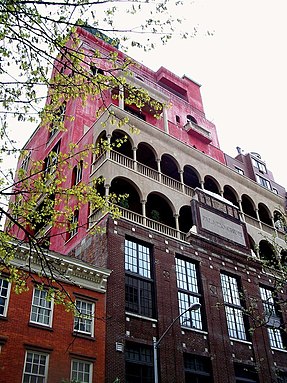Palazzo Chupi
40°44′07″N 74°00′32″W / 40.735296°N 74.009022°W

Palazzo Chupi is a residential
The building, which contains five "palatial"[2] units, is easy to spot because of its singular style and bold pink color.[3] The name is taken from the trendy Spanish lollipop called "Chupa Chups"; Schnabel used Chupi as a pet name for his second wife Olatz López Garmendia.[2]
Schnabel says that he built the Palazzo "because I wanted more space, and because I thought I could sell two or three apartments to pay for that space, and I built it because I could."[2]
Critical response
According to a description by Penelope Green in the
Art critic
But Andrew Berman, executive director of the Greenwich Village Society for Historic Preservation, describes Schnabel's building as "woefully out of context and a monument to this guy's ego." Berman has described the Palazzo Chupi as "an exploded Malibu Barbie house."[2] The building is situated less than a block outside the New York City Landmarks Preservation Commission's Greenwich Village Historic District Extension I,[5] and sits next door to 354 West 11th Street, a well-preserved Greek Revival row house dating from c.1841-42.[6]
References
- ^ "For Rent: Julian Schnabel's Palazzo Chupi," Kevin Brass, April 27, 2009. New York Times.
- ^ New York Times(November 12, 2008)
- ^ Barbanel, Josh (December 6, 2009). "Price Cuts of a Princely Kind". The New York Times. Retrieved May 7, 2010.
- ^ Before gentrification of the neighborhood began in the 1990s, the street was noted for its colorfully dressed and sexually eclectic transsexual prostitutes.
- ^ ""NYCLPC Greenwich Village Historic District Extension Designation Report"" (PDF). Archived from the original (PDF) on June 8, 2010. Retrieved June 2, 2011.
- ISBN 978-0-470-28963-1., p.58
